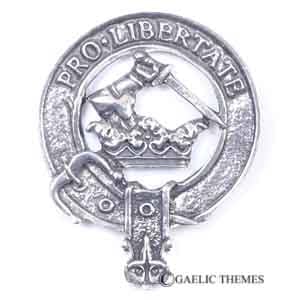Wallace
Select
- Design: Standard
- Clan Motto: Pro Libertate (For Liberty)
- Notes:
Crest: Issuat from a crest coronet of four (three visible) strawberry leaves Or, a dexter arm vambraced, the hand brandishing a sword all Proper
There are two theories on the origins of this name. The Waleis were Britons from Wales who held land in Shropshire and may have come north with David I. Or they were Britons who settled in Strathclyde in the tenth century. The name is found in twelfth century records in Ayrshire and Renfrewshire.
Around 1160, Richard Walensis of Riccarton held land near Kilmarnock as a vassal of the High Steward of Scotland. His grandson, Adam Walays, had two sons. The eldest succeeded to the estates in Ayrshire. The younger son, Malcolm, received lands in Elderslie. His son was the great William Wallace of Elderslie.
Malcolm was one of the few clansmen who refused to sign the Ragman Rolls submitting to Edward I of England. He was executed, but his wife escaped to Dundee with their son, William. William gathered together a small force of followers. His first serious action was revenge on his father’s executioner, Sir John Fenwick. Fenwick was marching towards Dundee with a train of booty captured from Scottish monasteries and churches when Wallace’s men ambushed him on Lowden Hill in Lanarkshire.
This success brought more recruits to Wallace’s guerilla war. He next allied with Sir Andrew Murray, a northeastern rebel, as well as with the Grahams, Campbells, and the Earl of Lennox.
Many Scottish nobles were indiscriminately executed by the English as a reprisal since they could not capture Wallace himself. A full-scale revolt in the south-west was quelled by a strong English force. This forced Wallace to flee north and regroup, gathering more troops. In 1297, he laid siege to Dundee. The English sent the Earl of Surrey with a large force to defeat Wallace. The sides met at Stirling Bridge, where Wallace’s reputation as a war leader was assured. For his victory against seemingly insurmountable odds, William was knighted and given the title of ‘Guardian of Scotland’. Sadly, he was later defeated at the battle of Falkirk. Wallace escaped the battle but was later betrayed and captured. He was sent to London and executed.
The Wallaces of Craigie descended from William Wallace’s uncle. Their estate came from a marriage. In 1669 Hugh Wallace of Craigie was created a Baronet of Nova Scotia. The second baronet, Reverend William Wallace of Falford, was a distinguished lawyer and rose to become Lord Justice Clerk (second highest judge in Scotland).
The son of the fifth baronet predeceased him so the estates passed to his daughter, Francis. She married John Dunlop of Dunlop in 1760. His eldest son assumed the name of Wallace and became the sixth baronet.
The chiefly line then shifted again to a cadet branch. The Wallaces of Cairnhill, who had lived in Jamaica for generations, took over estates in Ayrshire at Busbie and Clancaird. Captain Henry Wallace of Busbie and Clancaird established himself as chief of the name in 1888.
Robert Wallace received both the Belgian and French Croix de Guerre in World War I. His son, Malcolm, served in WWII, Korea and Borneo and rose to the rank of colonel. His brother, Ian, became the thirty-fifth chief in 1991.
